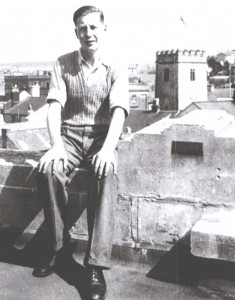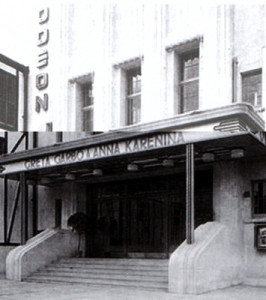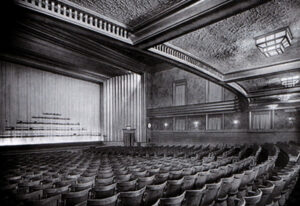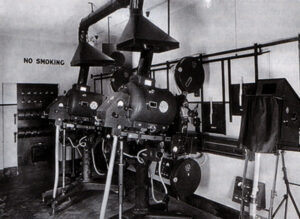
I recently came across photos of the old Odeon at Newton Abbot in Devon. My first real job after leaving Newton Abbot Grammar School in 1948 – aged 14 >/2 – was as a projectionist in that very cinema. A picture of the projection room evoked memories of the BTH projectors, the slide projector (for emergency notices) the stage lighting controls, and the small record/sound room.
The feature the week I started was She Wore a Yellow Ribbon with John Wayne and 1 saw it 18 times. The programme schedule was Sunday to Saturday – a feature film plus a ‘B’ film and a newsreel. Odeons always showed British Goumont News and these changed midweek (as did sometimes the main feature film)
The staff in the ‘box’, as it was known, were a chief projectionist, a female deputy and two boys. I was one of these, training to become third and second projectionists in the hierarchy. We worked six days a week, from noon until about 10.30pm – three programmes a day, with a children’s Saturday morning show.
We set up the film reels ready for use and re-wound the reels for the next showing. We checked for snags or breakages, which had to be repaired by cutting and using a special machine. Cinema-goers would see the film jump, indicating where a join had been made.
We put on records at the intervals and operated the screen curtains and the proscenium lights at the start and end of each film.
We also had to collect heavy metal boxes of film from the front steps, and remove security chains from the exit fire doors. Last thing at night we re-chained and locked them.

We checked and replaced all the light bulbs except the main auditorium lights, which had to be accessed from the roof space. Any blown ones were noted and replaced once a week by electricians.
On the roof was the large rectifier room, a huge mercury-filled unit supplying the power to the carbon rods, which were arced to provide the brilliant light needed in these BTH projectors.
Prior to opening, the cinema was sprayed with scented antiseptic. The Odeon cinemas had a centralised vacuum system
with piped outlets built into the walls – the cleaners carried hoses that they just plugged in. This was essential when one considers the many smokers of the time -there were ash trays on the back of all the seats.
Odeon staff totalled three in the projection room, three or four usherettes in smart red uniforms, two cash desk and ice cream sales ladies, the manager and a doorman/bouncer. Independent cinemas employed fewer staff and their standards were often well below those set by the larger Odeon and ABCs and had the reputation of being flea pits.
I was sent on holiday relief duties to Torquay and Exeter, and after about 18 months, I switched jobs to work with the two independent jointly owned cinema’s in Newton Abbot – the Alexandra and the Imperial. To save costs these two cinemas shared one Pathe News reel between them and the programmes were timed with a 15-minute break – in which we scuttled from one to the other with the film.
My first cinema – like so many others – has been demolished but lives on in the memory of many people in Newton Abbot.
I did not intend the film houses to be my career, knowing I had National Service in front of me. I enlisted in the RAF as soon as I was 171/2 and I never used my projection skills in my 12 years RAF service.
Pat Honey












